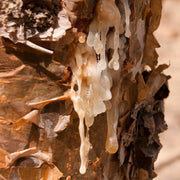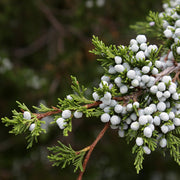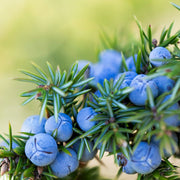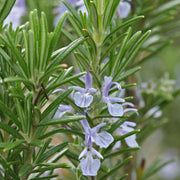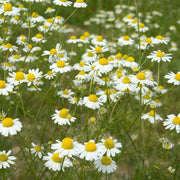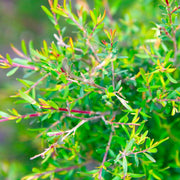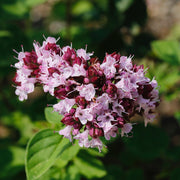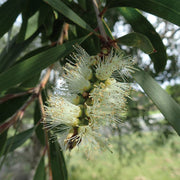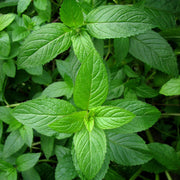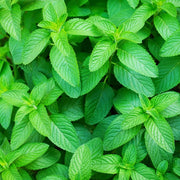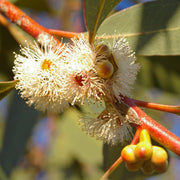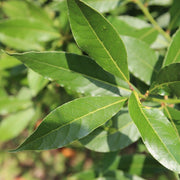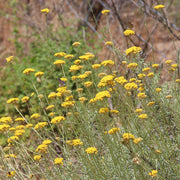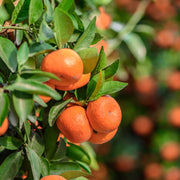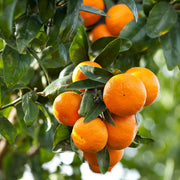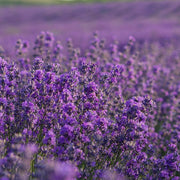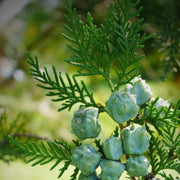Before I started using essential oils for allergies, springtime used to be hard for me. Even though spring in Montana is gorgeous, my seasonal allergies made it hard for me to enjoy this lovely season.

I live in the woods, surrounded by gorgeous conifers . . . and also by all of those flowering, pollen-producing trees, flowers, grasses, and plants that I just mentioned. Long story short, my seasonal allergies used to cause me severe discomfort. Sneezing, sniffling, watery eyes—the works.
It wasn’t until I took a holistic approach and started using essential oils for seasonal allergies that my symptoms calmed down.
First, I set out to understand just what was happening in my body (which was only doing its best to protect me), so I could calm those symptoms and feel better. Here’s what I learned . . .
My immune system was working hard to prevent harmful invaders from entering my body.
Allergens—like bee pollen, animal dander, dust mites, plants, and grasses—are not bacteria or viruses, but my immune system was still identifying them as harmful invaders (1).
It was creating allergic reactions to stop those invaders from entering my body. My cells sent out histamine, causing my blood vessels to expand and triggering symptoms like sneezing, coughing, runny nose, excess mucus, and itchy, watery eyes.
Comforted by the knowledge that my body was on my side, I decided to take a three-tiered approach to natural allergy relief:
- Support my body’s overall health and natural immunity
- Clear allergens from my environment
- Calm my most acute allergy symptoms as fast as possible!
Essential oils played a big role in all three steps.
How to calm your seasonal allergies
I’m also going to share effective methods for using essential oils for allergy relief in your life.
I’ll share how to manage your allergies naturally, methods for immediate symptom relief, which essential oils to use for allergies, and some of the best (and safest) ways to use them.
I’ll tell you WHY these essential oils work, so you understand the science.
You’ll also find suggestions for natural products, DIY products, and essential oils that can help with your seasonal allergies right away.
And last (but definitely not least!), I’ll tell you about some important safety considerations, so you can use essential oils for allergy relief without side effects you don’t want.
That sounds like a lot of information, but I promise it’s really not complicated! Let me walk you through each step so you can start using essential oils for allergies.
3 All-natural Steps to Keep Your Allergies at Bay
1. Support the body’s overall health and immunity
More often than not, our immune systems are overworked and overstressed because we’re surrounded by different kinds of toxins in our environments. Not only allergens and outdoor pollution, but also toxic chemicals in things like cleaning products and synthetic fragrances.
When I reduced my own allergies, I decided to support my immune system by removing as many of those products as possible.
My first steps:
- Replace conventional cleaning products with my own DIY all-natural, essential oil based versions.
- Stop using skin care products and perfumes made with synthetics
- Make sure to get plenty of sleep and relaxation, so my body was less full of stress hormones, and had access to its full resources of energy
Many of the products we use in our daily lives can cause skin allergies or other allergic reactions. Using a natural alternative can be a great place to start when you're trying to reduce allergic symptoms.
I noticed an immediate difference in my seasonal allergies after taking these steps!
2. Clear allergens from your environment

Once I had gotten rid of the chemicals that used to surround me and stress my immunity, I looked into ways to prevent other kinds of allergens from getting into my system where they could cause trouble.
Here are some of the best steps that I took for this:
- Change your bed linens regularly, to prevent allergens and dust mites from accumulating
- Freshen your linens between washes with a DIY essential oil linen spray that reduces dust mites and promotes sleep
- Take your shoes off before you enter the house (so you don’t track allergens inside)
- Take a comforting shower or bath before bed with a DIY anti-allergy salt scrub, so you go to sleep with immune-supporting essential oils on your skin instead of allergens
These lifestyle changes are so simple to make! Yet they go a long way toward promoting health and wellness and keeping allergens out of your home.
3. Calm your most acute allergy symptoms as fast as possible
Prevention is important!
But what about when the sneezing, watery eyes, itchy throat, and sinus headaches are so uncomfortable that you need relief NOW?
I have two “go-to” suggestions for immediate natural allergy relief:
- Flushing my sinuses with a neti pot or saline spray
- Using essential oils to support health and calm symptoms right away.
Why it works: Using essential oils for allergies

Why is using essential oils so effective for natural allergy relief?
Because essential oils are chemically composed of molecules that can relieve discomforts like inflammation, allergic rhinitis, coughing, phlegm and mucus, runny eyes, and congested airways.
We call these helpful, health-supporting molecules “chemical components”.
Essential oil components on your side
There are far too many natural essential oil components for me to cover in this post!
I’ll share some of the “powerhouses” that have been scientifically researched. If I see one of these components in an essential oil’s chemistry, I immediately know, “Oh, I can use this essential oil for allergy relief.”
- 1,8 cineole – the key component in eucalyptus essential oil, excellent for clear breathing and calming inflammation in sinuses and the throat (3).
- Terpinen-4-ol – this shows up in tea tree oil and peppermint essential oil, and has the effect of an antihistamine, reducing inflammation and relaxing muscles (3).
- Ketones (methone, carvone, camphor) – ketones show up in a variety of essential oils like lemon essential oil and spike lavender oil, and are known for reducing phlegm and mucus, while clearing airways (3).
These components are also useful for breaking up mucus, decongesting, and reducing microbes like bacteria and viruses (Aromatherapeutic Blending, p. 132-133) (3).
Since each component has its own approach to reducing allergy symptoms, I like to blend with a variety of essential oils that contain them. Using them in different ways (like natural cleaners and body products) also helps keep me protected.
I don’t want to leave any avenue open for allergies to get to me!
What are the Best Essential Oils to Use for Allergy Relief?
I’ve categorized some of the best essential oils for allergy relief into easy-to-navigate lists so you can immediately identify which oils to work with to create the benefits you need.
It’s a great idea to use oils from multiple lists, so you’re preventing and relieving allergies in multiple ways.
Essential oils with anti-inflammatory properties
- Frankincense Oil (Boswellia carterii)
- Cedarwood Oil (Juniperus virginiana)
- Juniper Berry Oil (Juniperus communis)
- Ravintsara Oil (Cinnamomum camphora ct 1,8 cineole)
- Rosemary ct Camphor Oil (Rosmarinus officinalis ct camphor)
Essential oils with anti-histaminic properties
- Tea Tree Oil (Melaleuca alternifolia)
- Marjoram (Sweet) Oil (Origanum majorana)
- German Chamomile Oil (Matricaria recutita)
Essential oils to open airways
- Spearmint Oil (Mentha spicata)
- Siberian Fir Oil (Abies sibirica)
- Laurel Leaf Oil (Laurus nobilis)
- Saro Oil (Cinnamomum fragrans)
- Rosalina Oil (Melaleuca ericifolia)
- Peppermint Oil (Mentha × piperita)
- Cardamom Oil (Elettaria cardamomum)
- Douglas Fir Oil (Pseudotsuga menziesii)
- Eucalyptus Dives Oil (Eucalyptus dives)
- Niaouli ct 1,8 cineole Oil (Melaleuca quinquenervia ct 1,8 cineole)
Essential oils for immune support
- Orange Oil (Citrus sinensis)
- Lime Oil (Citrus aurantifolia)
- Fragonia Oil (Agonis fragrans)
- Mandarin (Red) Oil (Citrus reticulata)
- Ghandi Root Oil (Homalomena aromatica)
- Thyme ct Linalool Oil (Thymus vulgaris ct linalool)
- Helichrysum Gymnocephalum Oil (Helichrysum gymnocephalum)
Essential oils for relaxation and stress relief
- Lavender Oil (Lavandula angustifolia)
- Spike Lavender Oil (Lavandula latifolia)
- Cypress Oil (Cupressus sempervirens)
- Plai (Central) Oil (Zingiber cassumunar)
- Rhododendron Oil (Rhododendron anthopogon)
The best ways to use essential oils for allergies
Now you have an excellent reference for which essential oils can help with different kinds of allergy issues.
But how do you use them?
Here are some of the best ways to use essential oils for allergies.
Again, it’s a good idea to choose multiple ways, so you’re preventing allergies from multiple angles. Make your life a “no allergies” zone!
Inhalation blends
Breathing in essential oils for allergy relief takes them right to the “scene of the action”—your respiratory system (4).
- Diffuser blends – Diffuse essential oils to support your immune system, while neutralizing airborne allergens. Diffuse 5 to 8 drops.
- Aromatherapy inhalers – Carry a DIY aromatherapy inhaler to breathe in essential oils anytime, anywhere. Use 6 to 12 drops in an inhaler.
- Room sprays – Spritz essential oils all around your room to reduce airborne allergens and microbes (and make the room smell great!) Use 25 to 40 drops in 2 to 4 oz of water or hydrosol.
- Steam blends – Slow down and inhale nourishing steam to calm inflammation and clear mucus out of your airways. Add 1 drop of an essential oil like tea tree oil to a bowl of steaming water, close your eyes, lean over the bowl, and breathe deeply. (Ahh!)
Topical blends

Using essential oils for allergy relief topically offers the same support as inhaling them . . . while also nourishing your skin!
- Body oils – Hydrate and nourish your skin, while surrounding yourself with essential oil support! I love oil blends for the evening. Blend 10 to 18 drops of essential oil into 1 oz of a carrier oil such as jojoba oil or coconut oil.
- Lotions – Moisturize your skin and get ongoing allergy relief throughout the day. I like lotions for daytime, while I prefer oils for night. Blend 10 to 18 drops of essential oil into 1 oz of lotion.
- Baths – Aromatherapy baths are a great way to relax, ease muscle tension, open your breathing, and wind down (5). I like to use 1 tbsp of castile soap with 6 to 8 drops of essential oil blended in.
- Salt scrubs – Exfoliate your skin, massage sore muscles, and cleanse away allergens in a warm bath or shower. Blend 8 oz of pink Himalayan salt, 4 tbsp of carrier oil (like jojoba), and 20 to 30 drops of essential oil.
Natural cleaning product blends

Replacing my chemical cleaning products with all-natural, essential oil versions had a huge, memorable impact on calming my allergy reactions to the spring season. They calmed down so quickly! I can’t recommend these methods enough.
- Cleaning sprays – Cleanse the surfaces in your home, reducing allergens and other microbes. Blend 45 to 60 drops of essential oil in 2 to 4 oz of water, hydrosol, or vodka).
- Air purifiers – This is like the room spray I shared in the Inhalation Blends section. Use 25 to 40 drops of essential oil in 2 to 4 oz of water or hydrosol.
- Cleaning scrubs – Deep clean your bathroom, tub, and tile with a concentrated essential oil scrub to remove dirt, grime, and allergens. You’ll find a great cleaning scrub recipe here.
Before I close, I want to share something very important.
Using essential oils safely

Don’t skip this section!
It’s very important to remember that essential oils are highly concentrated. A little goes a long way!
Be respectful of your essential oils and intentional with your essential oil blends.
And be sure to follow these safety guidelines when you’re using essential oils for allergies (or any other reason):
- For children under 10 - I like to avoid essential oils rich in the component 1,8 cineole, like eucalyptus oil.
- For people with asthma and other breathing conditions - I have them sniff the bottle first. If their chest feels tighter, I don’t use that oil for them.
- Use oils from reputable companies - Make sure you buy from companies that are transparent about their practices and offer products that are 100% pure—sustainably harvested, and either certified organic, organically grown, or wildcrafted. Buy from companies that respect their products and customers enough to share information like batch distillation and GC/MS test results.
- If a product comes with safety guidelines - On the label or packaging, be sure to follow those guidelines.
- Do not use essential oils directly on the skin - Without diluting them in a carrier oil first. I never recommend undiluted topical use of essential oils, unless you’re a certified aromatherapist. Some essential oils can actually harm the skin if they’re used in this way. Be sure to dilute your essential oils in a carrier before applying them topically.
- Do not consume essential oils - I never recommend consuming essential oils, unless you’re a certified aromatherapist. Without the proper knowledge and education, using essential oils internally is not advisable.
I hope this post has empowered you!
You now have the knowledge—based on science and research—of the best ways of using essential oils for allergy relief, and how to reduce allergies in your life holistically.
There are simple recipe suggestions above, as well as links to essential oil kits to make your journey to health simple and fun. If you ever start to feel confused about how to use the oils (or about other information you find online) please feel free to come back to this post and clarify your understanding. You can even print it out for reference.
At Aromatics, we are passionate about knowledge! Do you have a favorite way to use essential oils for allergies? Please tell us in the comments, or share what methods you’re excited to try.
Learn more!

Lastly, if you're looking for more information on how you can reduce allergies naturally with essential oils, we'd love to recommend a FREE webinar hosted by our good friend Andrea Butje, of the Aromahead Institute. You can find more information about the webinar HERE!









